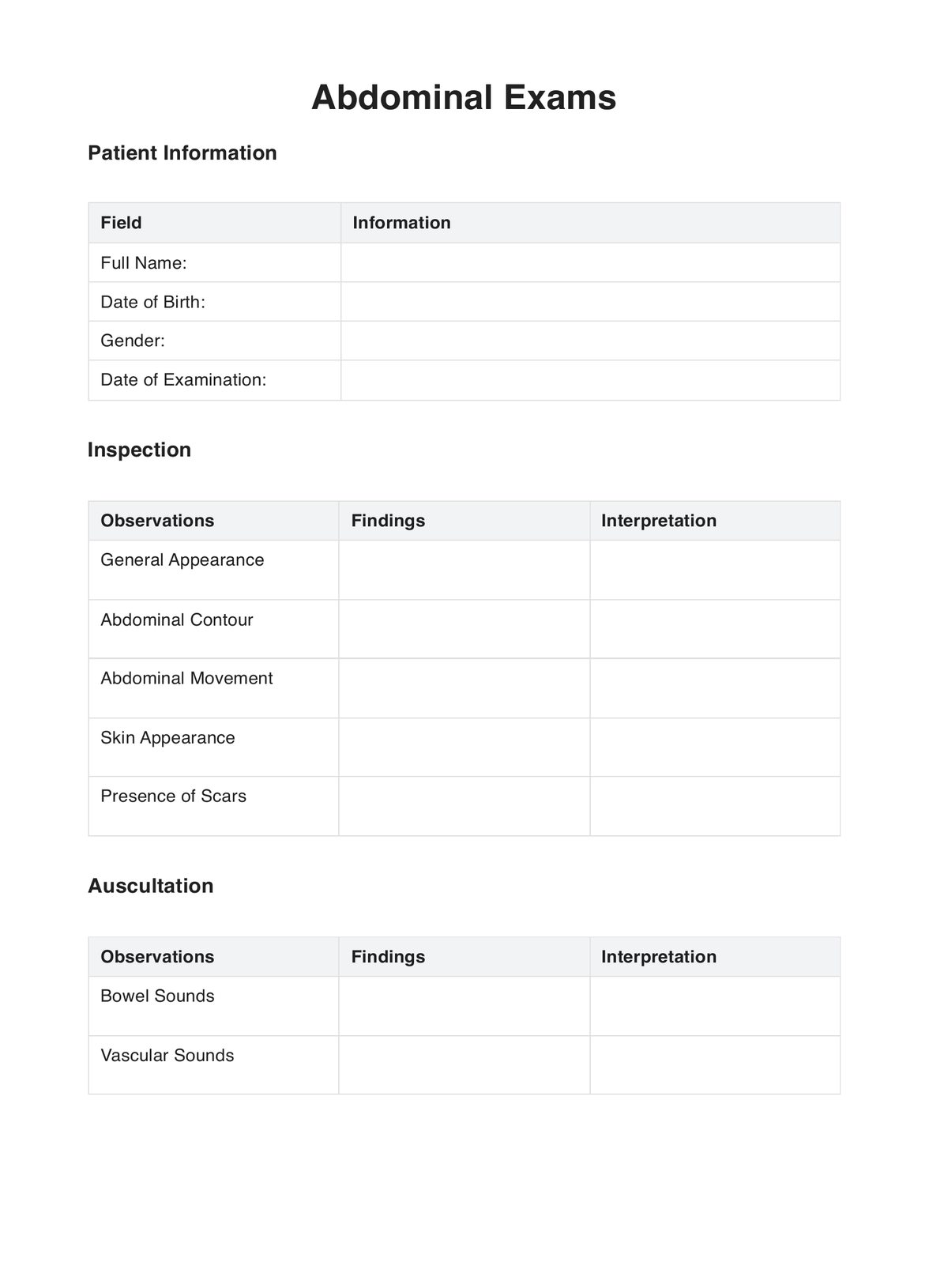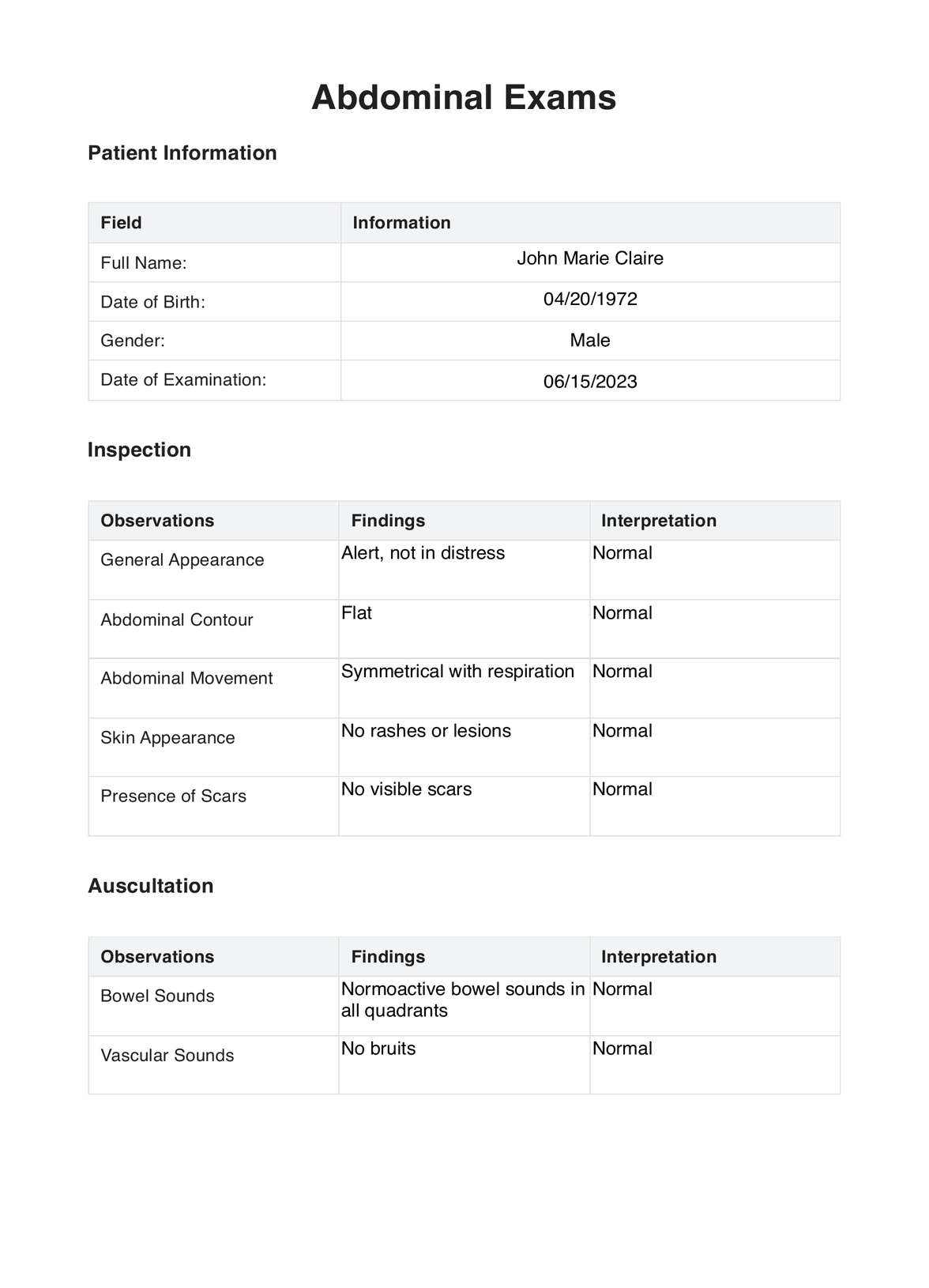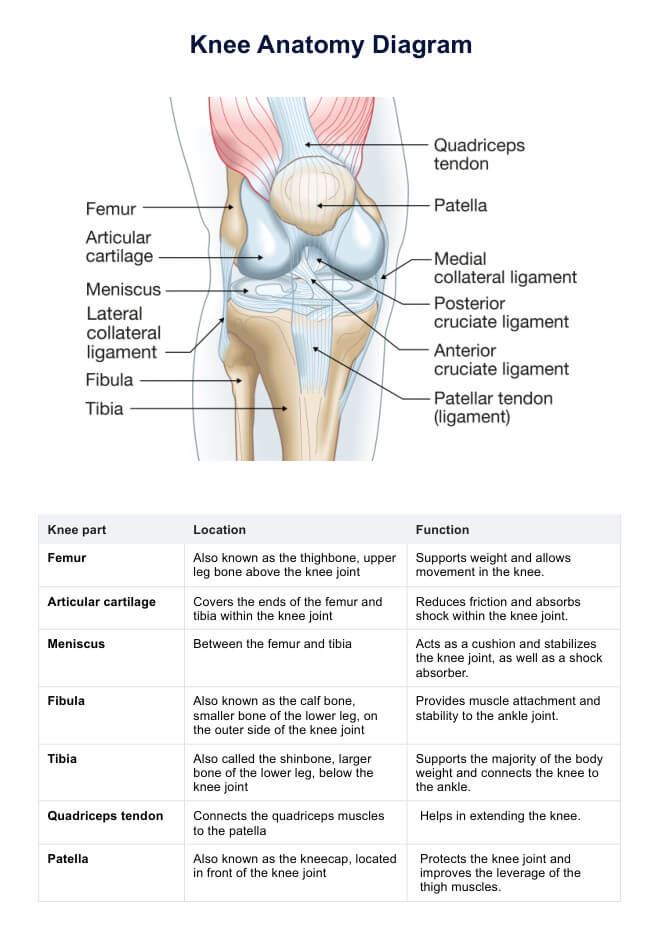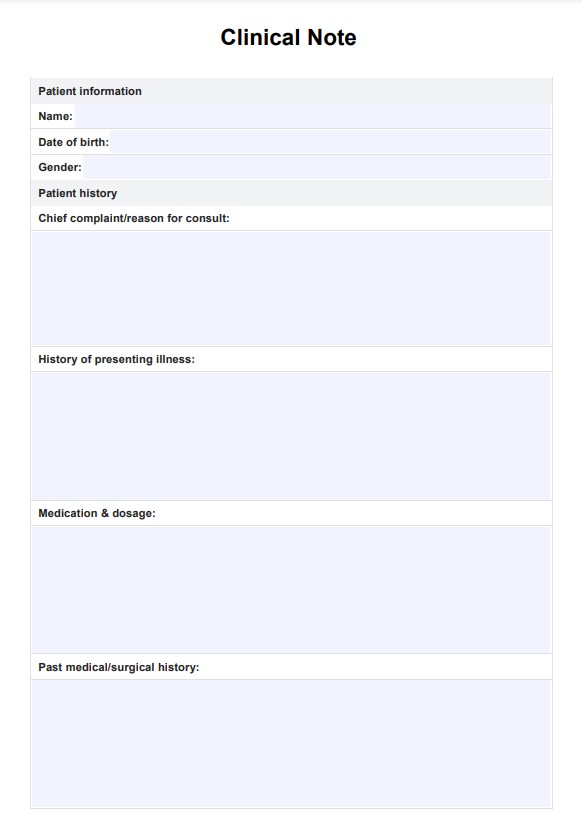Abdominal Exam
Master abdominal exams with our comprehensive guide & free PDF template. Streamline your practice with Carepatron, your ideal abdominal exam app.


What is an Abdominal Exam?
An abdominal exam is a vital component of a comprehensive physical examination that focuses on evaluating the health and well-being of the abdomen. This intricate process involves a systematic assessment of various aspects, encompassing palpation, auscultation, and inquiries into the patient's medical history. Whether you're a seasoned professional or a student just starting, mastering the art of the is an absolute must.
During light palpation of the patient's abdomen, the healthcare provider carefully examines the abdominal wall and muscles. This hands-on approach allows them to detect any abnormalities, tenderness, or palpable masses that may indicate underlying issues. The examination extends beyond surface-level observations, delving into deep palpation, where the healthcare provider probes the abdominal cavity to assess for potential organ enlargement or abnormalities. This includes checking for the presence of an abdominal aortic aneurysm or signs of liver pathology.
Abdominal auscultation is another crucial aspect of the exam, involving the listening for bowel sounds. The absence, presence, or patterns of bowel sounds can provide valuable insights into the functionality of the gastrointestinal tract. In addition to these techniques, specific checks for individual organs are performed, such as palpating the liver edge or assessing for renal artery bruits, contributing to a comprehensive understanding of the patient's abdominal health.
The examination is not limited to physical assessments; it also involves a thorough exploration of the patient's medical history. This includes inquiring about symptoms like abdominal pain, distension, or chronic issues, which aids in uncovering potential underlying pathologies. Whether investigating signs of inflammatory bowel disease, acute abdominal pain, or chronic liver disease, the abdominal exam plays a crucial role in the diagnostic process.
Moreover, physical findings during the exam, such as signs of peritoneal inflammation or the presence of voluntary and involuntary guarding, contribute to a nuanced assessment. This detailed evaluation allows healthcare providers to tailor their approach, leading to more accurate diagnoses and effective treatment plans. Overall, the abdominal exam stands as a cornerstone in clinical medicine, offering a holistic perspective on the patient's abdominal health and guiding healthcare professionals in delivering optimal care.
This is where our free downloadable PDF comes into play. We've compiled a guide as a roadmap for a comprehensive abdominal exam. Packed with step-by-step instructions and practical examples, this guide will augment your clinical skills and bolster your confidence during the procedure. Stay tuned, and get ready to enrich your practice!
Abdominal Exam Template
Abdominal Exam Example
How does it work?
The abdominal examination is a cornerstone of the physical diagnostic process. With our comprehensive "Printable Abdominal Exam Template," healthcare professionals can systematically perform this crucial assessment and effectively document their observations. Here's a breakdown of how the template works:
An abdominal exam is a comprehensive assessment of the abdomen, involving the examination of various components to evaluate the patient's abdominal health.
During an abdominal examination, healthcare professionals systematically assess various components of the abdominal region to gain valuable insights into a patient's health. This involves checking the integrity and tone of abdominal muscles for signs of abnormalities or muscle-related conditions. The abdominal wall is examined for distension, tenderness, or abnormalities, providing diagnostic clues. Listening for normal bowel sounds aids in detecting gastrointestinal irregularities, while abdominal palpation helps identify tenderness, masses, or other abnormalities beneath the skin surface. Special attention is given to detecting an abdominal aortic aneurysm.
The position and characteristics of abdominal organs are assessed for normalcy and signs of organ-related issues. Deep palpation and assessment of deep breath help identify abnormalities not detectable through surface examination. Specific evaluations, such as checking for chronic liver disease and signs of severe liver disease, contribute to understanding overall health. The examination also considers patient history, asking about symptoms and assessing chronic abdominal pain. Rebound tenderness and auscultation for bowel sounds provide further diagnostic information.
Clinical considerations and examination of the entire abdomen ensure a comprehensive evaluation, while specific assessments for conditions like inflammatory bowel disease and portal hypertension guide diagnosis and management. Palpation of the anterior superior iliac spine and evaluation for peritoneal inflammation are integral parts of this thorough examination. The healthcare provider may also perform a rectal examination for colorectal assessment. Overall, the abdominal examination covers a range of elements, from the muscles and organs to specific conditions, ensuring a holistic understanding of the patient's abdominal health.
The abdominal exam is a crucial aspect of clinical medicine, aiding in the diagnosis of conditions ranging from inflammatory bowel disease to acute abdominal pain. Physical findings, including signs of peritoneal inflammation or voluntary and involuntary guarding, contribute to a thorough assessment of the patient's abdominal health.
When would you use this template?
Healthcare professionals operate in a vast field with varied situations requiring specific tools and resources. Our Abdominal Exam Template is no different—it's designed for particular circumstances in which professionals often find themselves.
Routine check-ups
The Abdominal Exam Template is an excellent tool for regular health check-ups. A comprehensive abdominal examination can be part of an overall patient assessment to ensure their well-being and detect potential problems early.
Patient complaints
The template is invaluable when a patient presents with abdominal discomfort, pain, bloating, or other digestive complaints. This structured format guides healthcare professionals to examine and document their findings thoroughly.
Follow-up examinations
The template is handy for follow-up exams where patients are monitored for known abdominal conditions. It provides a consistent format for recording observations, enabling better tracking of the patient's progress or identifying any changes in their situation.
Training purposes
This Abdominal Exam Template can be a learning aid for medical students or newly qualified professionals. It provides a structured format that guides them through the steps of a comprehensive abdominal exam, ensuring every crucial aspect is noticed.
Quality control
To maintain a high standard of patient care, it's essential to have consistent and comprehensive documentation. This template aids in achieving that by providing a detailed and systematic format for conducting and recording abdominal exams.
Remember, the usage of this Abdominal Exam Template is multifaceted. Whether for routine check-ups, addressing patient complaints, conducting follow-up exams, or for educational purposes, this template provides the structure and detail necessary for thorough and consistent documentation. Utilizing resources like this helps enhance the quality of patient care, making them integral in modern healthcare settings.
Benefits of Using the Free Abdominal Exams Template
The Free Abdominal Exams Template offers several benefits, making it a valuable tool for healthcare professionals and patients alike. Here are some key advantages:
- Comprehensive assessment: The template guides healthcare providers through a systematic and comprehensive abdominal examination process. It ensures that no crucial aspect of the examination is overlooked, promoting a thorough evaluation of the patient's abdominal health.
- User-friendly format: The template is designed with user-friendliness in mind. Its clear and structured format makes it easy for healthcare professionals to follow, enhancing the efficiency of the examination process.
- Accessibility: Being a free template, it promotes accessibility for healthcare providers in various settings. Whether in a clinical setting, primary care office, or emergency room, the template can be readily accessed and utilized.
- Educational tool: For medical students, residents, or healthcare professionals seeking to enhance their skills, the template serves as an educational resource. It provides a structured framework for learning and practicing abdominal examination techniques.
- Patient understanding: The template can also be shared with patients as a visual aid. It helps explain the different components of the abdominal exam, fostering patient understanding and engagement in their healthcare.
- Time efficiency: By offering a standardized format, the template contributes to time efficiency during examinations. Healthcare providers can move through the various steps of the exam with clarity, reducing the likelihood of omissions or redundancies.
- Diagnostic support: The systematic approach facilitated by the template aids healthcare providers in identifying potential issues or abnormalities in the abdomen. This, in turn, supports more accurate diagnoses and timely interventions.
- Record keeping: The template allows for the documentation of examination findings. This record-keeping aspect is crucial for maintaining a patient's medical history, tracking changes over time, and facilitating communication among healthcare providers.
Research & evidence
Abdominal examination has been an integral part of medical practice for centuries. Historically, the process has been used to detect abdominal diseases, helping clinicians form a diagnosis and choose appropriate treatment plans. The longstanding use of abdominal examinations, coupled with the modernization of practice, has led to the development of systematic and structured approaches such as the Abdominal Exam Template we have today.
Modern medical research supports the use of these structured examination approaches. A study published in the British Journal of Surgery found that systematic abdominal examinations have a high degree of accuracy in identifying surgical diseases. This research strongly supports the use of structured approaches in examining the abdomen.
Moreover, research has also found benefits in using structured templates in healthcare. A 2014 study in the International Journal for Quality in Health Care showed that using templates in healthcare improves the completeness of documentation, enhances communication among healthcare professionals, and aids in delivering quality patient care.
Therefore, using an Abdominal Exam Template like ours, supported by medical history and research, is a highly beneficial practice. It facilitates comprehensive, consistent, and efficient exams, improving patient care and outcomes. This resource builds on a rich history of medical practice, with the evidence supporting its use, making it a reliable tool for healthcare professionals today.
References
British Journal of Surgery. (2009). The accuracy of abdominal examination in the diagnosis of abdominal aortic aneurysm. https://bjssjournals.onlinelibrary.wiley.com/doi/abs/10.1002/bjs.6600
International Journal for Quality in Health Care. (2014). Standardized templates for clinical records promote quality management. https://academic.oup.com/intqhc/article/26/1/57/1826066
Commonly asked questions
The Abdominal Exam Template is designed explicitly for abdominal examinations. While it provides a comprehensive approach to this particular assessment, it may only be suitable for some types of medical exams, which may require different parameters.
Absolutely! The Carepatron Abdominal Exam App is designed to work seamlessly across various devices, including smartphones, tablets, and computers, allowing you to conduct, record, and share abdominal exams wherever you are.
Yes, Carepatron allows you to share the results of the abdominal exam directly with your patient. This feature fosters transparency and allows for an open discussion about the patient's health status and the next steps in their care.
















































































































